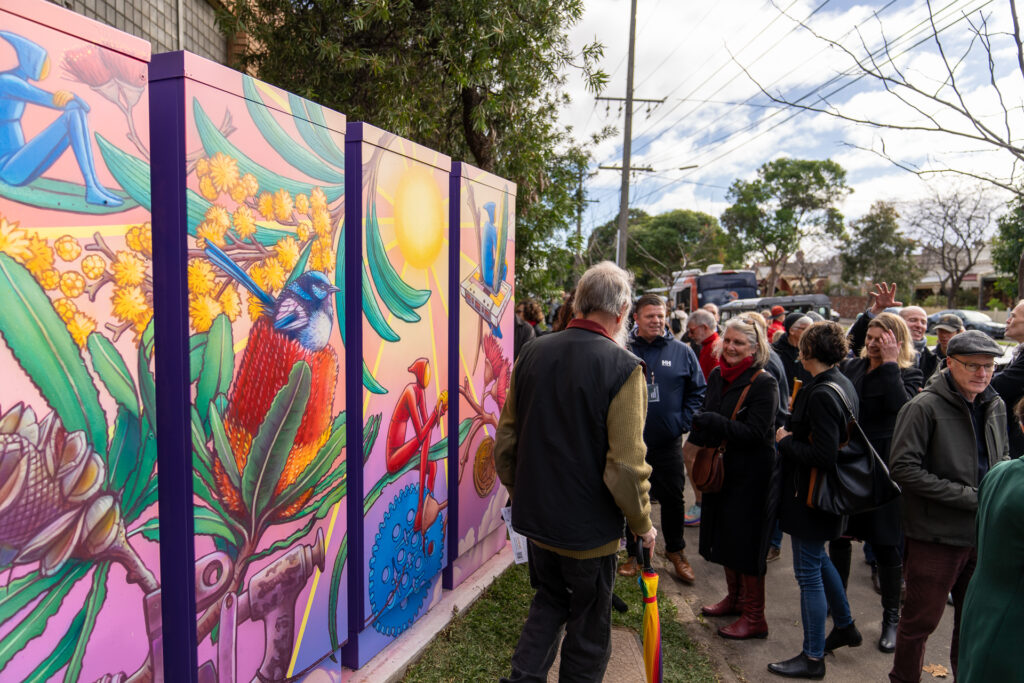
Project Overview
Duration: One year (April 2023 – April 2024)
Budget: $270,000
Researchers: Marnie Shaw and Dora He
Partners: Energy Consumers Australia
How trial network tariffs impact the potential benefits of Neighbourhood Batteries: Report
How neighbourhood batteries can unlock network capacity for Consumer Energy Resources: Report
Recent state and federal elections sent a clear message that communities want strong, local democracy and action on climate change. In our research, we’ve been hearing this same message over the past few years when we speak to Australians about what they want from our future energy system. Community batteries align with these values, so it is unsurprising that there is almost universal enthusiasm for this technology from households.
Community batteries, or neighbourhood batteries (a more general term), are a type of mid-scale storage ranging from 0.1 to 5 MW located in front of the meter in the distribution network, connected to a group of households or businesses. The battery may be owned by energy retailers, distribution networks (DNSPs), local councils and community groups or organisations, to provide a wide range of potential services and benefits.
In response to the enthusiasm for community batteries from voters as well as the energy industry more broadly, the Australian Federal and state governments have now collectively committed $300 million to community battery trial schemes.
This project is focused on understanding how to get the best outcomes for consumers from the national roll-out of neighbourhood batteries and communicating that understanding to promote changes in the roll-out to better achieve consumer benefits.
Part of our role as researchers is to identify knowledge gaps, generate robust evidence to inform these gaps and translate this evidence into policy recommendations. Importantly we are building on existing and extensive BSGIP social research around neighbourhood batteries.
The goal of this project is to provide the evidence to inform best consumer outcomes and communicate our recommendations to decision makers. The specific questions this project is researching are:
1) Can neighbourhood batteries minimise rooftop solar curtailment, increase solar export limits for customers? How can we ensure these, and other financial benefits are passed on to all customers, including non-solar owners?
(2) Which neighbourhood battery trial tariffs result in the best outcomes for consumers?
Project elements
Hosted and organised by BSGIP, the working group runs monthly and is a highly successful example of respectful communication and discussion between academics, industry, energy market bodies, DNSPs, government and community.
2. Partnerships
Partnerships are essential for this project to achieve the objective of informing the roll-out of neighbourhood batteries in the best interests of consumers. We both inform and are informed by our partners. In particular:
Upskilling and learning from community groups and businesses
Supporting and learning from network businesses, e.g., by providing evidence-based recommendations for tariffs to trial
Communicating with industry bodies, and being informed by the work they are doing (e.g. in the DEIP project)
3. Communication and impact
This project will deliver targeted research to inform decision makers including governments, electricity networks and regulators. Regular workshops will be held and follow-up reports written and disseminated to stakeholders.
As part of this project we are hosting the second national neighbourhood battery conference to be held on campus at the Australian National University in November 2023.
Find out more
The National Community-Scale Battery Working Group (CSBWG)
Neighbourhood Battery Knowledge Hub
Evaluating and tracking impacts of neighbourhood batteries
Neighbourhood Battery Initiative
Related links and publications
- A mutually beneficial approach to electricity network pricing in the presence of large amounts of solar power and community-scale energy storage. Energy Policy, Vol 159, December 2021
- Applying responsible algorithm design to neighbourhood-scale batteries in Australia. Nature Energy, July 2021. Full text free version.
- Algorithms are driving the digitisation of our energy system – we must design them responsibly, Blog post by Marnie Shaw.
- Implementing community-scale batteries – Final report
- Implementing community-scale batteries: regulatory, technical and logistical considerations
- Stakeholder views on the potential role of community scale storage in Australia
- Community batteries: a cost/benefit analysis
- Operating a community-scale battery: electricity tariffs to maximise customer and network benefits
- Victoria’s first inner-urban community battery heralds in a new age in shared renewable energy storage
- Victorian Government Department of Energy, Environment and Climate Action Neighbourhood Battery Initiative
- Community/neighbourhood-scale batteries – Battery Storage and Grid Integration Program (bsgip.com)
- Neighbourhood-batteries-in-Australia, PV Tech Power journal article
- Neighbourhood batteries: If you want to bring power to the people, you need to listen to what they want, Renew Economy article
